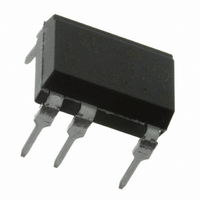PR33MF51NSZF Sharp Microelectronics, PR33MF51NSZF Datasheet - Page 8

PR33MF51NSZF
Manufacturer Part Number
PR33MF51NSZF
Description
RELAY SSR TRIAC OUT 300MA 8-DIP
Manufacturer
Sharp Microelectronics
Series
PR33MFr
Datasheet
1.PR33MF51NSZF.pdf
(14 pages)
Specifications of PR33MF51NSZF
Circuit
SPST-NO (1 Form A)
Output Type
AC
Load Current
300mA
Voltage - Input
1.2VDC
Voltage - Load
0 ~ 240 V
Mounting Type
Through Hole
Termination Style
PC Pin
Package / Case
8-DIP (0.300", 7.62mm), 7 Leads
Load Voltage Rating
600 V
Load Current Rating
0.3 A
Output Device
Triac
Maximum Operating Temperature
+ 85 C
Minimum Operating Temperature
- 30 C
Lead Free Status / RoHS Status
Lead free / RoHS Compliant
On-state Resistance
-
Lead Free Status / Rohs Status
Lead free / RoHS Compliant
Other names
425-2647-5
■ Design Considerations
(*) See Fig.2 about derating curve (I
Output
Operating temperature
Input
● Recommended Operating Conditions
● Degradation
● Degradation
In order for the SSR to turn off, the triggering current (I
In phase control applications or where the SSR is being by a pulse signal, please ensure that the pulse width
is a minimum of 1ms.
When the input current (I
voltage across the Triac, V
tion, please incorporate a snubber circuit. Due to the many different types of load that can be driven, we can
merely recommend some circuit values to start with : Cs=0.022μF and Rs=47Ω. The operation of the SSR
and snubber circuit should be tested and if unintentional switching occurs, please adjust the snubber circuit
component values accordingly
When making the transition from On to Off state, a snubber circuit should be used ensure that sudden drops
in current are not accompanied by large instantaneous changes in voltage across the Triac.
This fast change in voltage is brought about by the phase difference between current and voltage.
Primarily, this is experienced in driving loads which are inductive such as motors and solenods.
Following the procedure outlined above should provide suffi cient results.
Any snubber or Varistor used for the above mentioned scenarios should be located as close to the main out-
put triac as possible.
All pins shall be used by soldering on the board. (Socket and others shall not be used.)
In general, the emission of the IRED used in SSR will degrade over time.
In the case where long term operation and / or constant extreme temperature fl uctuations will be applied to
the devices, please allow for a worst case scenario of 50% degradation over 5years.
Therefore in order to maintain proper operation, a design implementing these SSRs should provide at least
twice the minimum required triggering current from initial operation.
Input signal current at ON state
Input signal current at OFF state
Load supply voltage
Load supply current
Frequency
Parameter
T
(rms) vs. ambient temperature).
F
) is below 0.1mA, the output Triac will be in the open circuit mode. However, if the
D
, increases faster than rated dV/dt, the Triac may turn on. To avoid this situa-
V
I
I
Symbol
OUT
I
OUT
F
F
(OFF)
(ON)
T
(rms)
f
opr
(rms)
Locate snubber circuit between output terminals
8
(Cs = 0.022 μ F, Rs = 47 Ω )
F
) must be 0.1mA or less
Condition
−
−
−
−
−
PR33MF51NSZF Series
MIN.
− 20
20
50
−
−
0
Sheet No.: D4-A03901EN
I
80%(*)
T
MAX.
(rms)×
240
0.1
25
60
80
Unit
mA
mA
Hz
˚C
V
A














